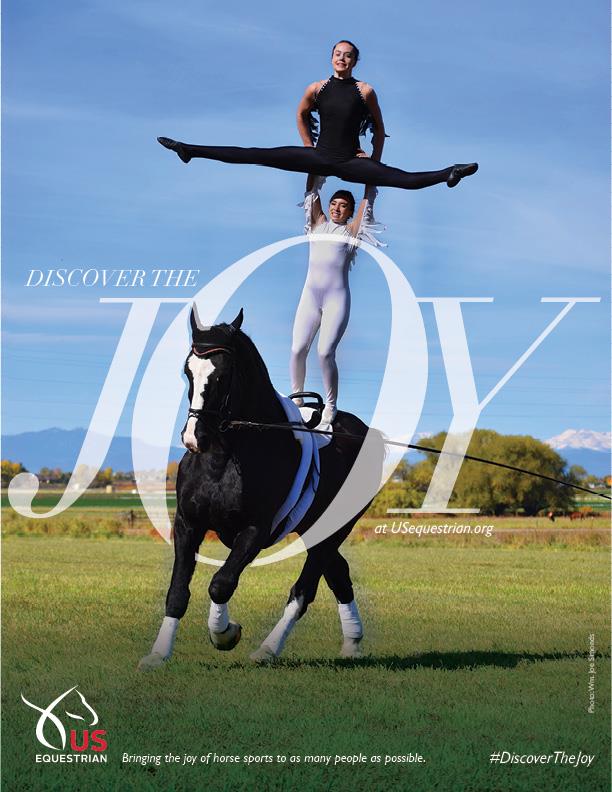
U.S. vaulting athletes and fans are mourning the death of a gentle giant, Jodi Rinard’s 19-hand Percheron, Sampson, who had carried athletes at Mile High Vaulters in Fort Lupton, Co., for 15 years. The iconic gelding died in late May at age 21.
An outpouring of memorial posts on Sampson’s Facebook page prompted Rinard to create an informal list of vaulting athletes who had competed on the enormous black-and-white horse, and she was up to 108 when she paused to share her memories of Sampson.
“The list includes little tiny tots who had fun rounds on him all the way to our top competitors in the country,” Rinard said. “That doesn’t even count the people who tried him in fairs, parades, or practices and people who just got to sit up there on him. You could probably quadruple that number if you included everyone who’d actually been on him.”
Announcing his passing, Rinard described Sampson as “the giantest and gentlest of gentle giants,” and those who knew him responded with memories of everything from great competitive moments to Sampson’s tendency to escape from his stall and wreak havoc in the barn aisle.
What made Sampson so special, Rinard said, wasn’t just his grand size. It was also the combination of a kind, level-headed temperament and exceptional athleticism that expressed itself in a breathtaking canter.
“He had the best native canter I’ve ever seen on a draft horse,” Rinard said. “He just had a beautiful, stunning lift to his canter. I had someone from Germany come to try him out before the World Equestrian Games™ in 2010; he was short-listed for the 2010 Games, but we didn’t actually go. So this woman came over
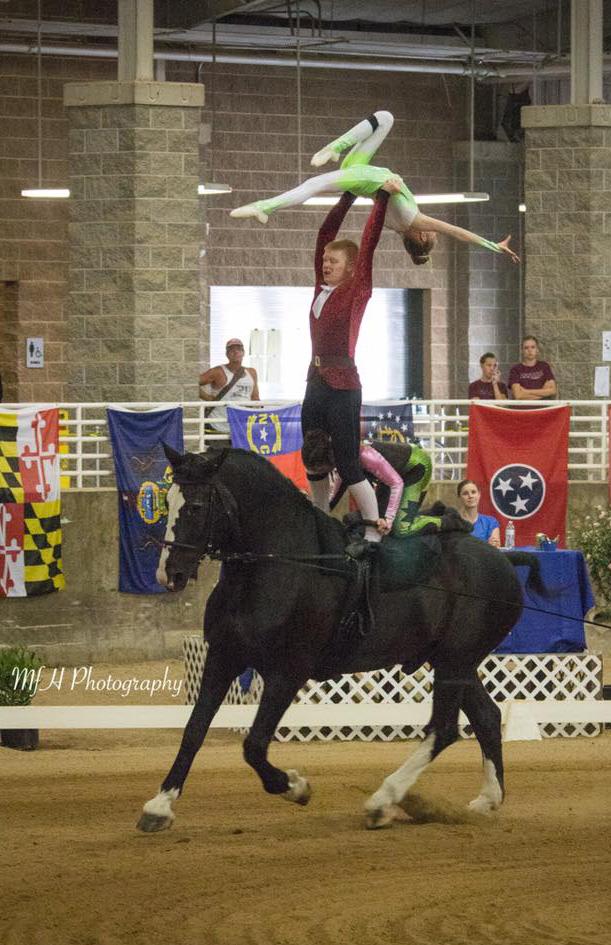
Photo: MfH Photography
from Germany to try him out, and when she went to get on him, she nearly went straight over his back to the other side. Anyone who was used to getting on draft horses would find themselves way up in the air, much higher than they expected to be, because he had such a serious canter with such serious suspension and lift in it. His canter was his best gait, which is also very rare.”
“One of my greatest memories of working with him was cantering next to him and hardly being able to reach the handle, because he was so tall and so massive, but as long as you could reach your fingers barely around the handle of the surcingle, his lift would launch you up,” vaulter Kayla Morgan Ade wrote on Facebook. “It was an amazing feeling that I will never forget. But even though he might have been the biggest horse in the AVA [American Vaulting Association], he was so gentle and willing to be such a good boy.”
“He Grew and Grew and Grew”
Sampson arrived at Mile High Vaulters in 2004. The club was just two years old, and Sampson became one of its first horses after literally outgrowing his previous job.
“A woman in California had bought him as a weanling,” Rinard explained. “She had been looking for a draft-horse temperament, because she wanted the horse for her disabled child, and Sampson for sure had that temperament. She was looking for a horse that she could set her child on and let the kid walk around, and you could do that with Sampson, but he just became too big. … He grew and grew and grew.”
When Sampson grew much too big for the child, the owner in California turned him out. By the time Rinard bought him, he was 19 hands tall and had had little training.
“Once he got so big, she didn’t do anything with him, so he grew up thinking, ‘I just do what I want to do,’” Rinard said. “When I got him, he really had no manners. He walked through fences, and for about a month we couldn’t bring him out of his stall with just a halter—you had to put a bridle on him, because otherwise you couldn’t stop him. He’d go wherever he felt like going. He was never mean about it; it was just that nobody had taught him horse manners. Nobody taught him that horses do what people say. So he’d wander off on his own. He would just ignore us in the beginning.”
At his first vaulting competition, Sampson caused a ruckus when he dismantled a temporary stall.
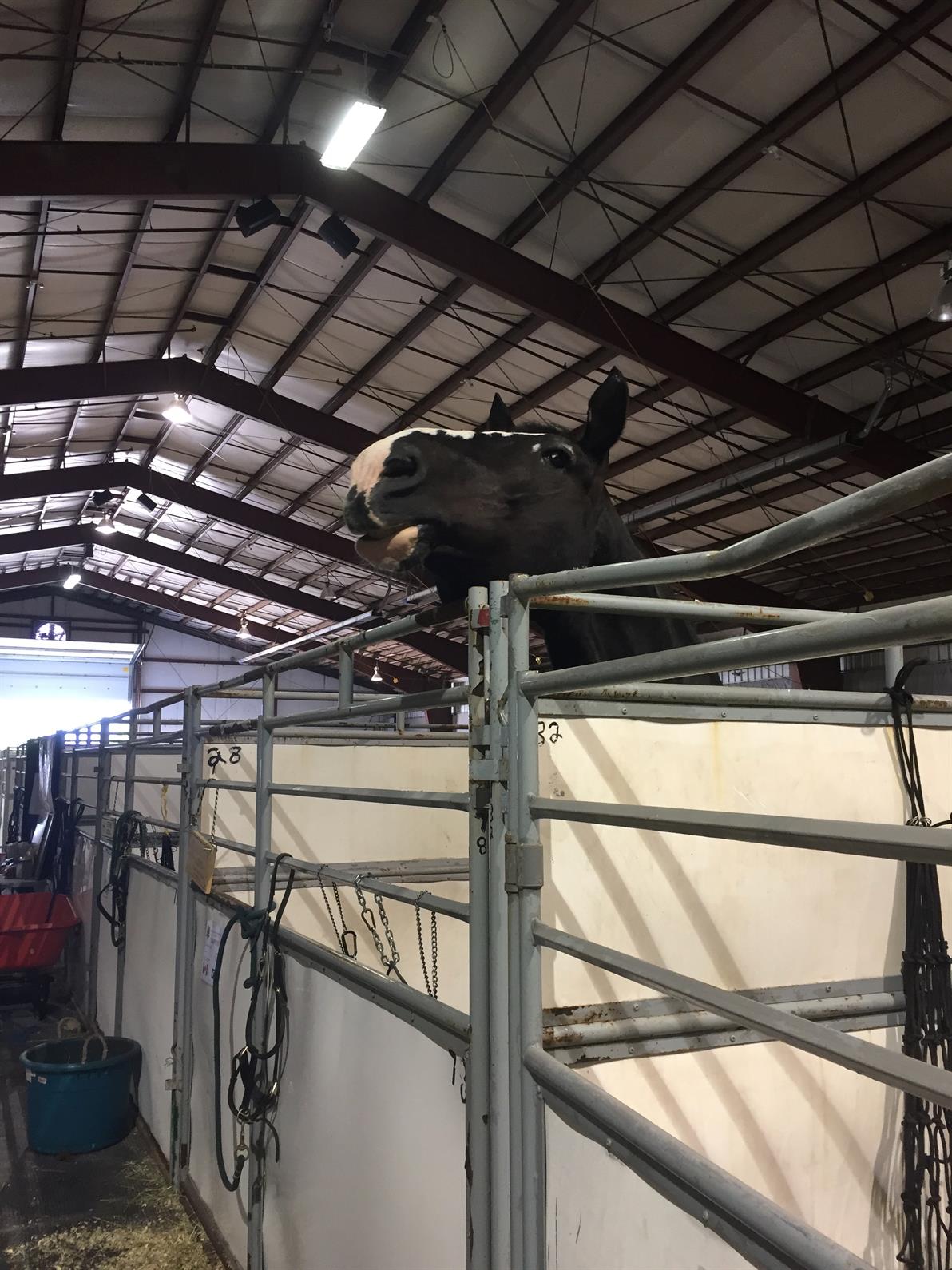
Photo: Don Potraz
“Well, his friends left, and he decided he was coming, too,” Rinard recalled. “He did not like being left in the stall, so he just took the door off. He just leaned. He was one of the most destructive animals I have ever worked with; he’d just lean on things until they broke.”
His talent for escaping became infamous at his home barn, too.
“One morning when I went into the barn, and the first thing I noticed was that the trashcan was knocked over and there was trash everywhere,” Rinard recalled. “My first thought was that we had raccoons in the barn. Then I noticed that his stall was open. I found him lying down on his side taking a nap in the middle of the indoor arena. He had let himself out his stall, wandered through the aisleway, knocked over all the hay piles and the trashcan and some barrels, and he broke at least three brooms—I don’t know why he didn’t like brooms, but he would stomp on them.
“So he was lying there in the arena, taking a nap. When I walked in, he heard me come in. He got up, looked at me, got up, and walked straight past me into his stall. He turned around in his stall and looked out, like, ‘It’s breakfast time, right?’”
A Champion and an Icon
But Sampson also was talented, kind, and brave, which contributed not only to his development as an iconic vaulting horse, but to the club’s growth, too.
“He for sure was a ham,” Rinard said. “He was also afraid of nothing, which is another benefit to a vaulting horse. You could
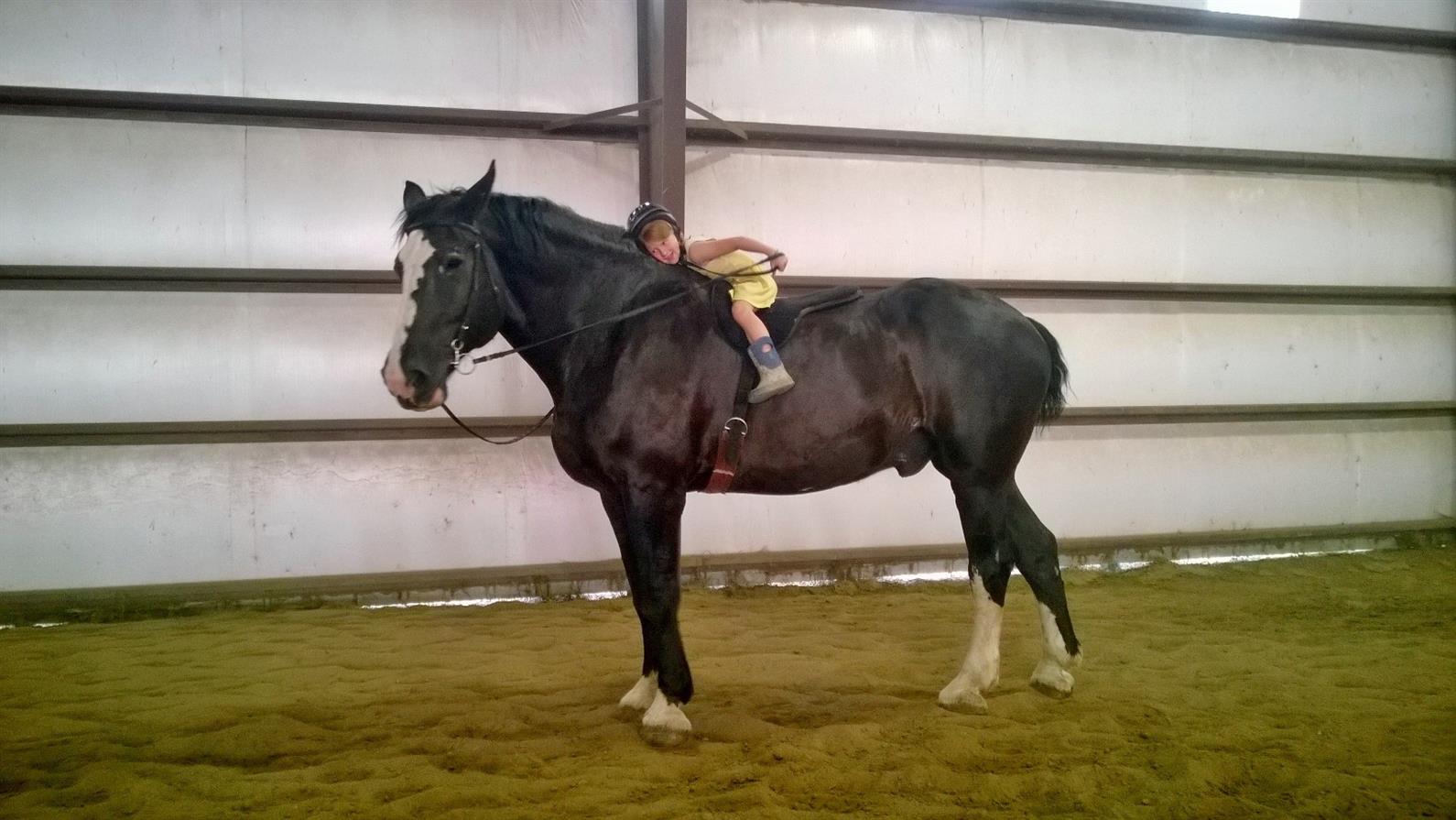
Photo: Ginger Thacker
take him into any almost situation—although he was afraid of the sheep at a horse show once. But, except for the sheep, you could take him in a parade with fire engines and marching bands. You could take him into new environments, and he was really afraid of nothing.”
Sampson gave hundreds of children a start in vaulting, thanks in large part to that imperturbable temperament.
“The little kids could always just scramble up his side,” Rinard said, describing how even the smallest Mile High vaulter could “climb their way up the horse like he was a tree. He never cared if you climbed. The little ones would get on by themselves and people would cheer just for that!
“He sort of built my club,” she added. “He would do anything and carry anything, and you could just do things with him. He was so versatile that he let us do anything we wanted, and that’s how we grew from being a little bitty club to being a bigger club with kids with the potential to qualify internationally.”
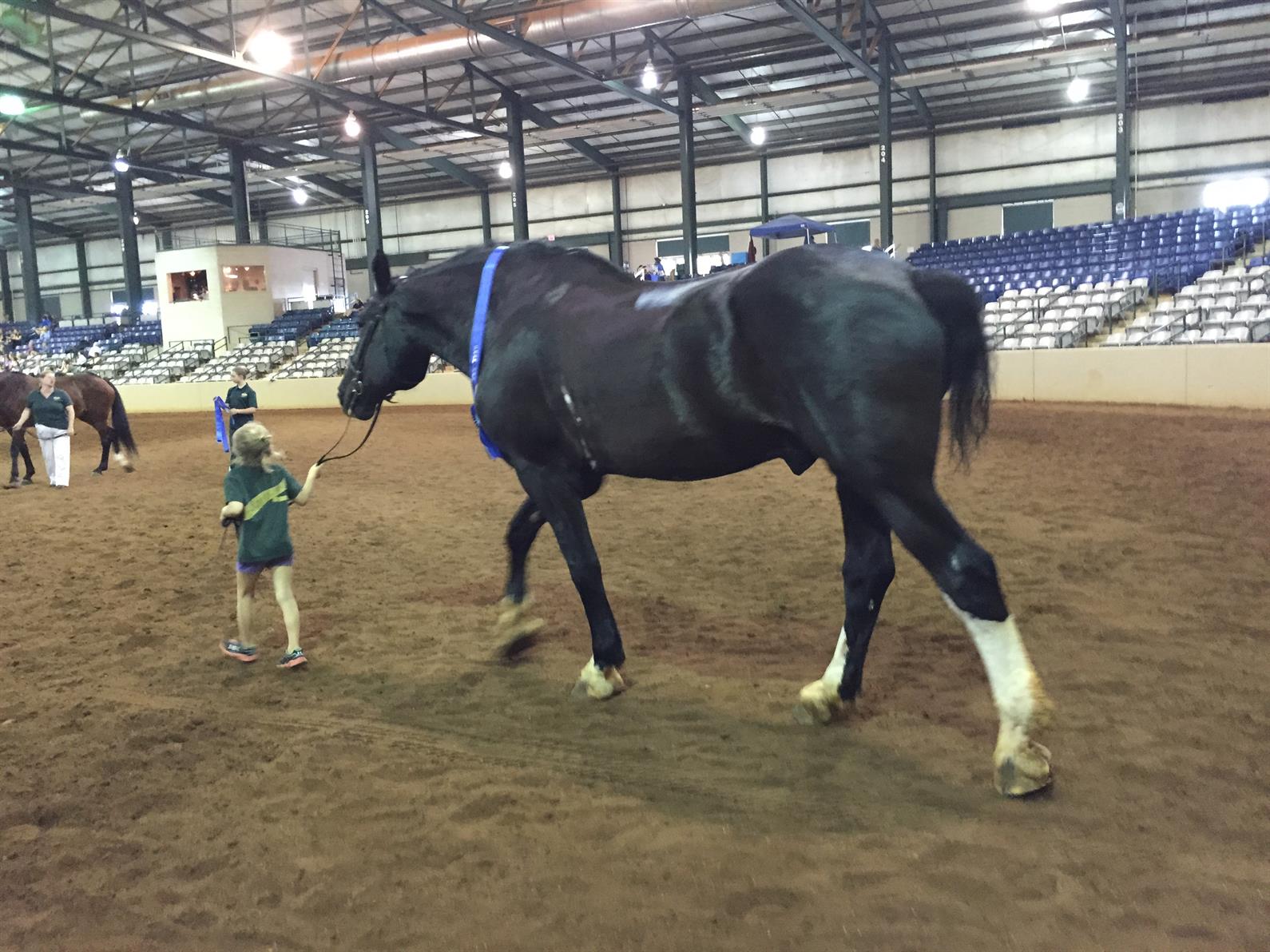
Photo: Loree Crow
Sampson went on to become the AVA’s B Team and open pas de deux Horse of the Year in 2015 and the A Team Horse of the Year in 2017. He also contributed to countless vaulting national championships.
One of Rinard’s favorite championship moments was when [FEI World Equestrian Games medalist] Blake Dahlgren and [WEG gold medalist] Megan Benjamin won the 2012 USEF/AVA National Vaulting Championship in Lexington, Ky., for their pas de deux aboard Sampson; they went on to take bronze for their pas de deux that year at the 2012 WEG in Le Mans, France, on a different horse.
“Blake, I’m guessing, is somewhere between 6’4” and 6’6” and is one of about three people that ever vaulted on Sampson who were about a match for Sampson in terms of height!” Rinard said. “When Blake mounted him the first time, he was like, ‘Is this how everyone else feels when they’re vaulting?’
“Anita Mills [of Triangle Equestrian Vaulting] said when she first saw him that she was ‘equal parts astonished and smitten,’ and that’s one of my favorite descriptions,” Rinard said. “I think we were all astonished and smitten by him, every time we saw him.”


